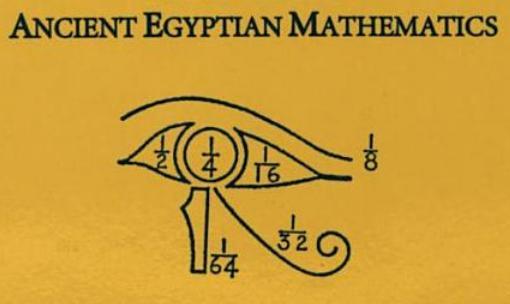- You have an assignment due today.
- You also have an assignment which is due this coming
Monday, 9/19 (to carry out some Egyptian multiplications and
divisions). This is in preparation for your exam on Friday of
next week. The exam will cover everything we've done up to
Egyptian multiplication and division.
- Last time:
- Review Egyptian Multiplication
- Egyptian division
- Now -- back to those Egyptians....
Our Question of the Day: How did the Egyptian Priests use the unit fraction table? - More Egyptian division...
-
Examples:
- Here's a relatively easy one: Suppose Fatima had 3
loaves to share between 4 people. How would she do it?
- the Egyptians restricted themselves to
the so-called "unit fractions", which are
fractions of the form 1/m: unit
fraction table, which is found on the Rhind
Papyrus (which dates to around 1650 BCE).
But they didn't restrict themselves to "halving", as our next example shows. Divide 6 by 7:
1 7 1/2 3+1/2 * 1/4 1+1/2+1/4 * 1/7 1 1/14 1/2 * 1/28 1/4 * The starred entries on the right add up to 6:
6=(3+1/2)+(1+1/2+1/4)+(1/2)+(1/4). We always look to the righthand part of the table to get the product as a sum of those numbers. Thenn the answer is the sum of fractions on the lefthand side of the table:1/2+1/4+1/14+1/28 - A little trickier:
- How would you divide 5 by 7?
- How can we use Fraudini and the unit fraction table to get the same answer?
- Something unusual: you can get two different representations for the same division problem
- How would you divide 23 by 9?
- How can we use Fraudini and the unit fraction table to get the same answer?
- Why did
Egyptians do things this way? (an example division problem, using binary)
Dominic Olivastro, "Ancient Puzzles", suggests a third reason why this use of unary fractions is good. Consider the problem Ahmes poses of dividing 3 loaves of bread between 5 people. We would answer "each person gets 3/5-ths of a loaf". If we implemented our solution, we might then cut 2 loaves into 3/5 | 2/5 pieces, with bread for 3 people; then cut one of the smaller pieces in half, giving the other two people 2/5 + 1/5 pieces. Mathematically acceptable, but try this with kids and they will insist that it is not an even division. Some have larger pieces, some have smaller. Ahmes would calculate 3/5 as : 3/5 = ()3 + ()5 + ()15 [ = 1/3 + 1/5 + 1/15 ] Now cut one loaf into fifths, cut two more into thirds, then take one of the 1/3-rd pieces and cut it into 5-ths (for the 1/15-th pieces), and you can now distribute everyone's 3/5-ths share in a way that _looks_ equal, since they will have exactly the same size pieces. (And no, I don't want to argue about the crust.)
(This illustrates that the priest would have used the unit fraction table, rather than our method -- which would have given us the answer 1/2+1/10 -- both answers are right! But I (and mathematicians in general) think that our shorter answer is better....)
- Joke: How would you like to do story problems like this one?!
- Here's a relatively easy one: Suppose Fatima had 3
loaves to share between 4 people. How would she do it?
- Today's New Topic: Busting up numbers (bases)
- So far we've been busting up numbers in different ways. The first
way was illustrated by the number 1729, and its base 10 representation.
What does each of the digits in the number 1729 mean?
- The story of base 10....
- Place value
- One of my favorite early introductions to bases was Tom Lehrer's New Math.
- The Great Fraudini writes numbers in base 2 (see p. 11).
- 47=32+8+4+2+1
- 89=64+16+8+1
- For your homework, you should have read this bases
reference. Other bases are used constantly -- for example, in this web
page. How so?
- This page uses HTML to control its appearance. For example, the
background color for this page is given by the command
<body bgcolor="#FFF8DC">
What does #FFF8DC have to do with color?
- What are some other bases that we use in our lives? Where?
- This page uses HTML to control its appearance. For example, the
background color for this page is given by the command
- Translating between bases
- Write 53 (base 10) in base 2
- Write 100101101 (base 2) in base 10
- So far we've been busting up numbers in different ways. The first
way was illustrated by the number 1729, and its base 10 representation.
